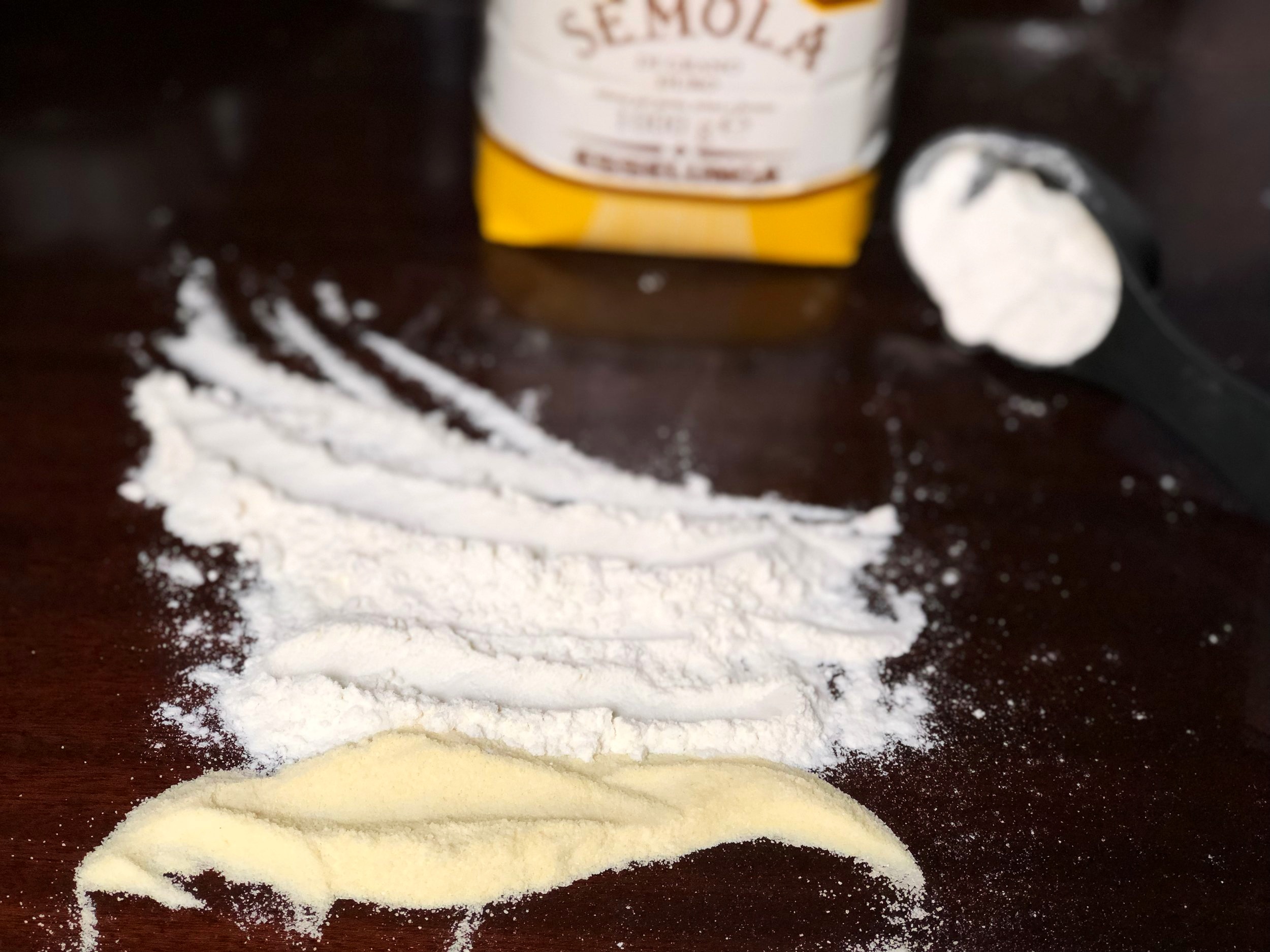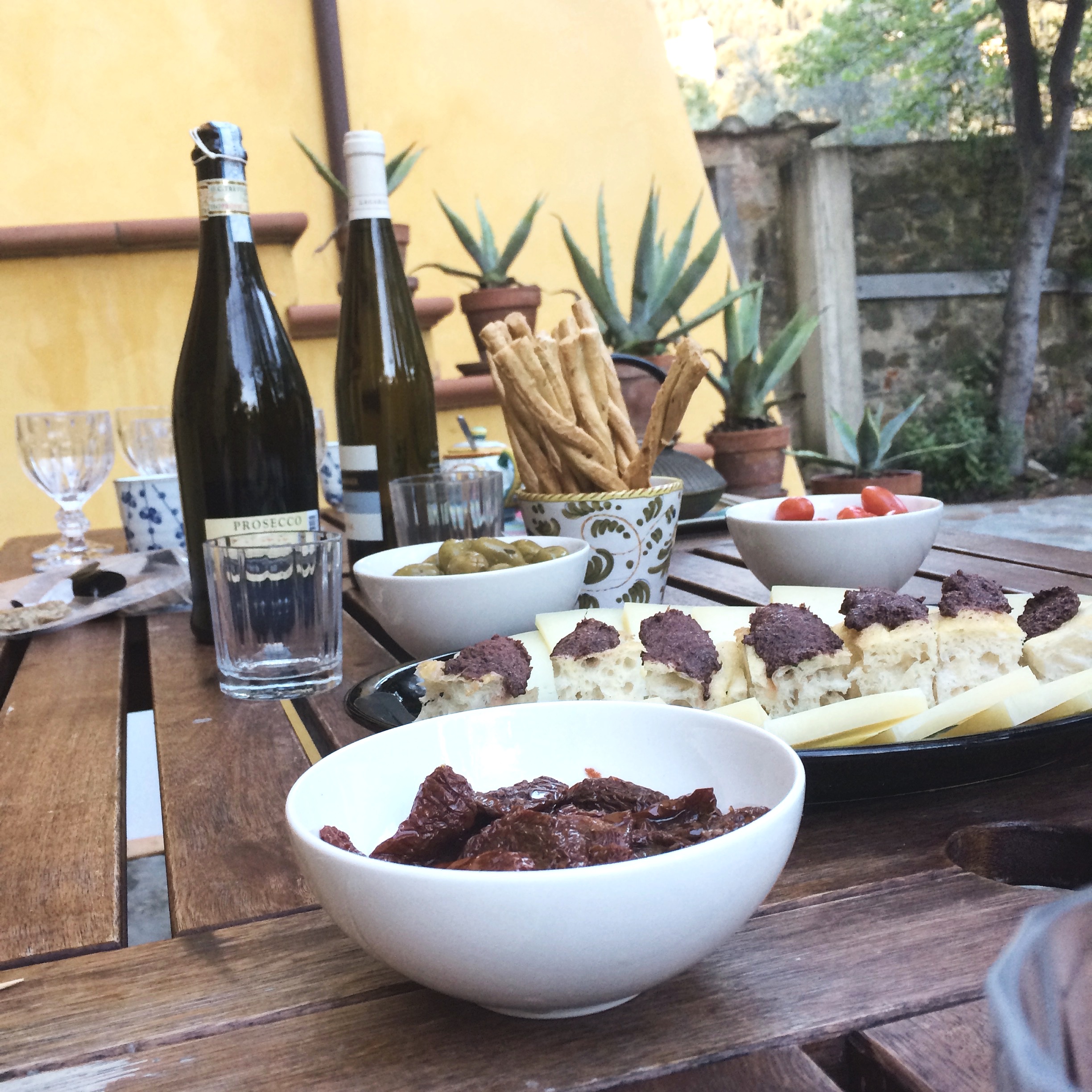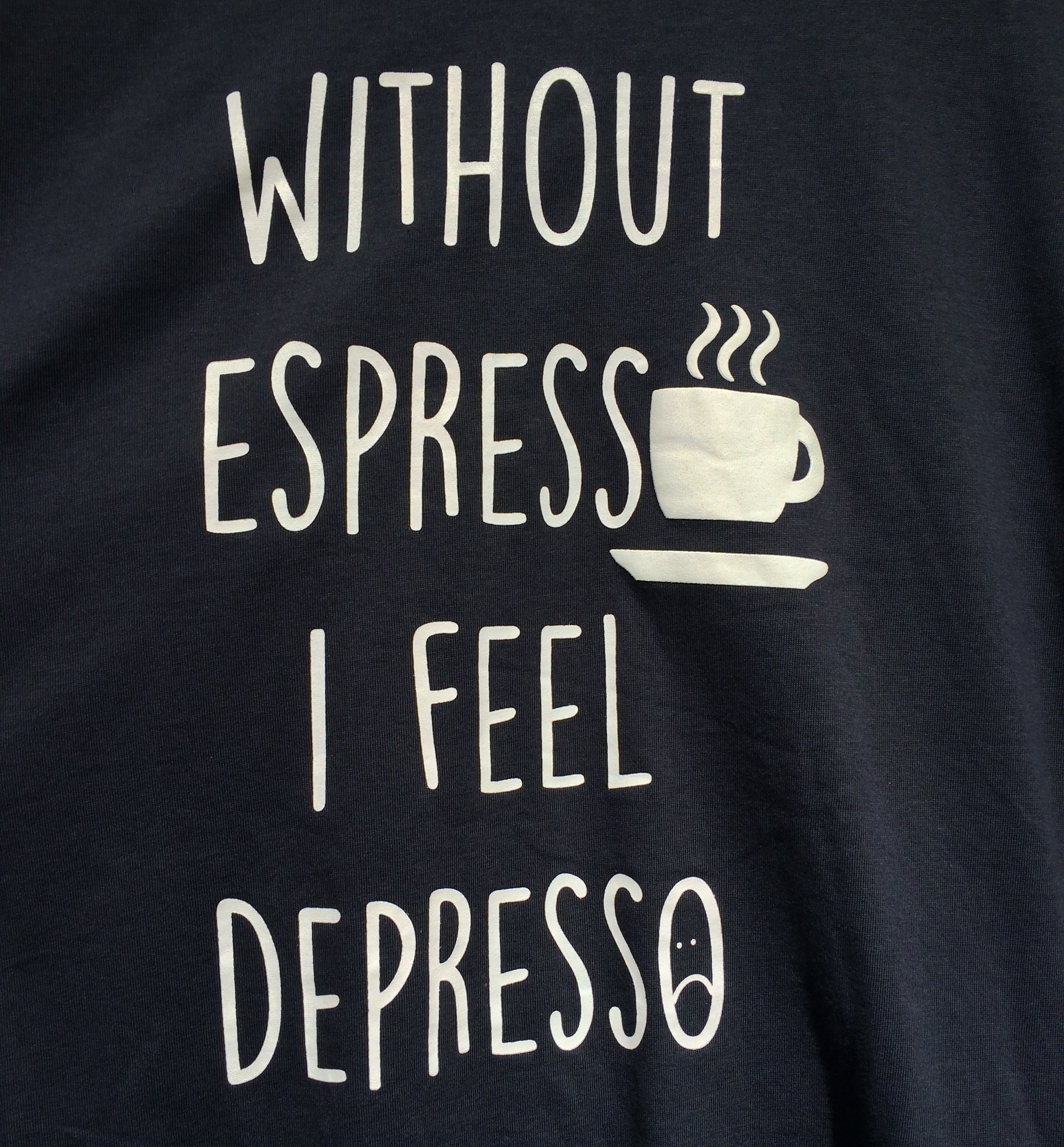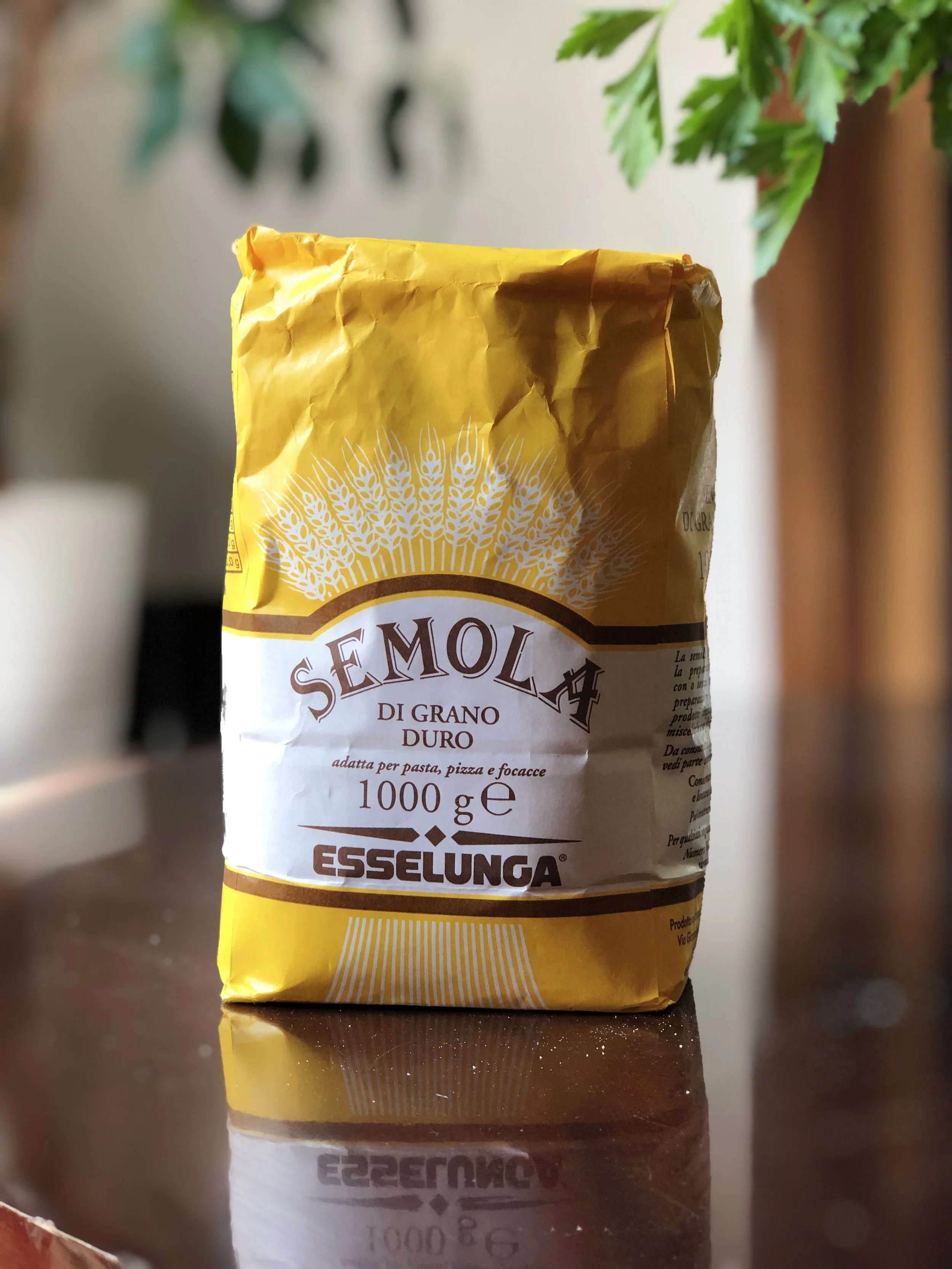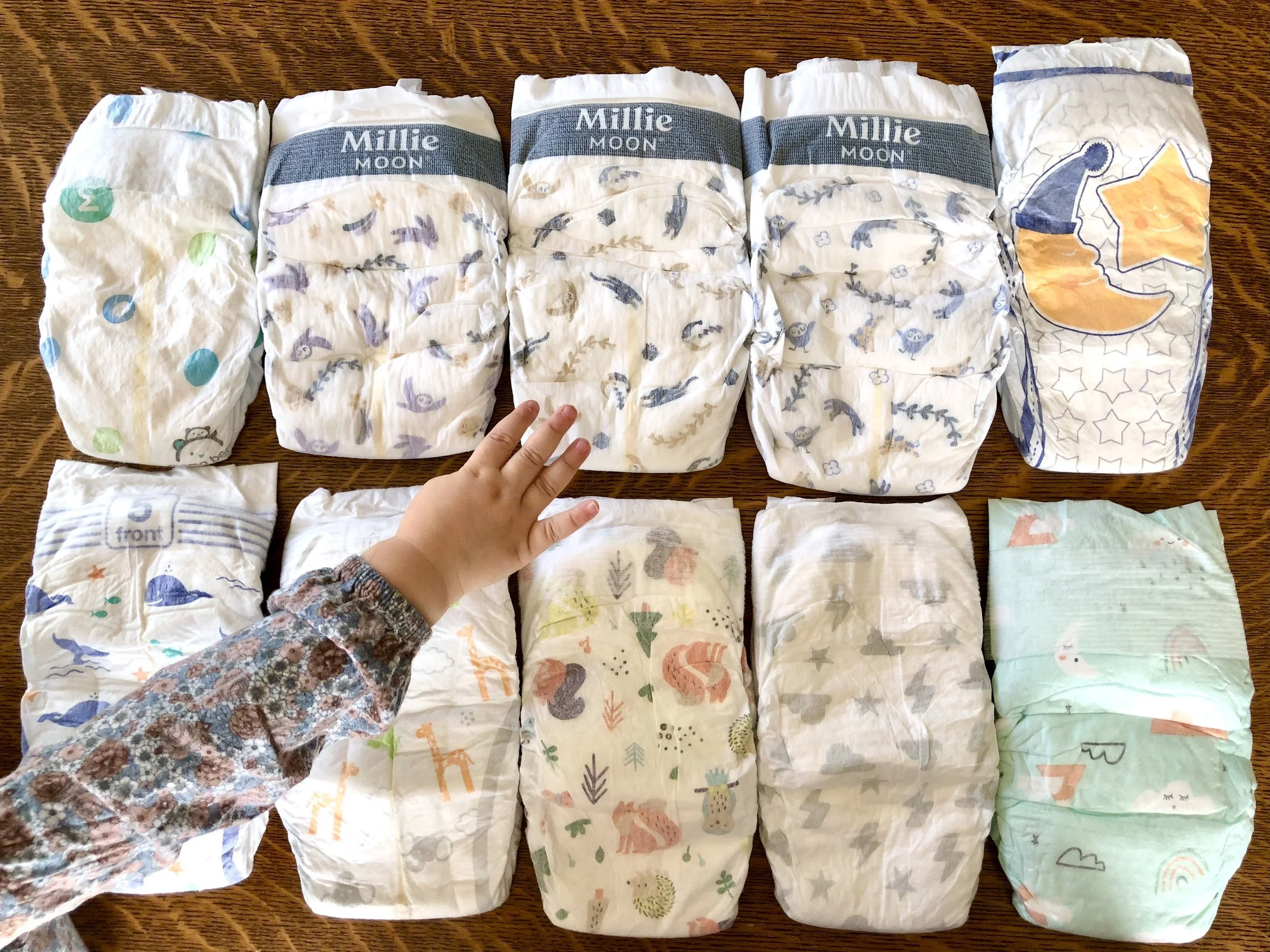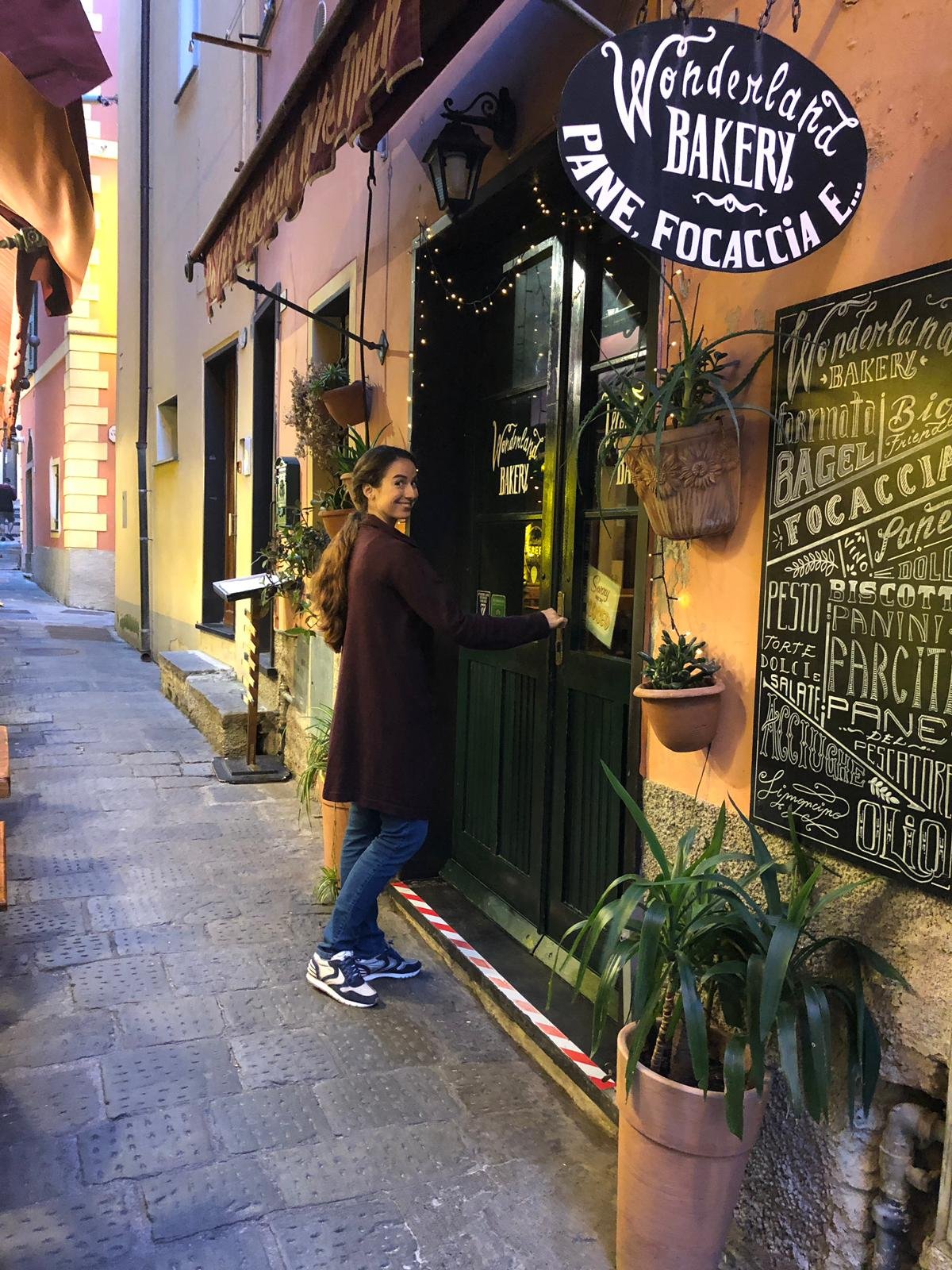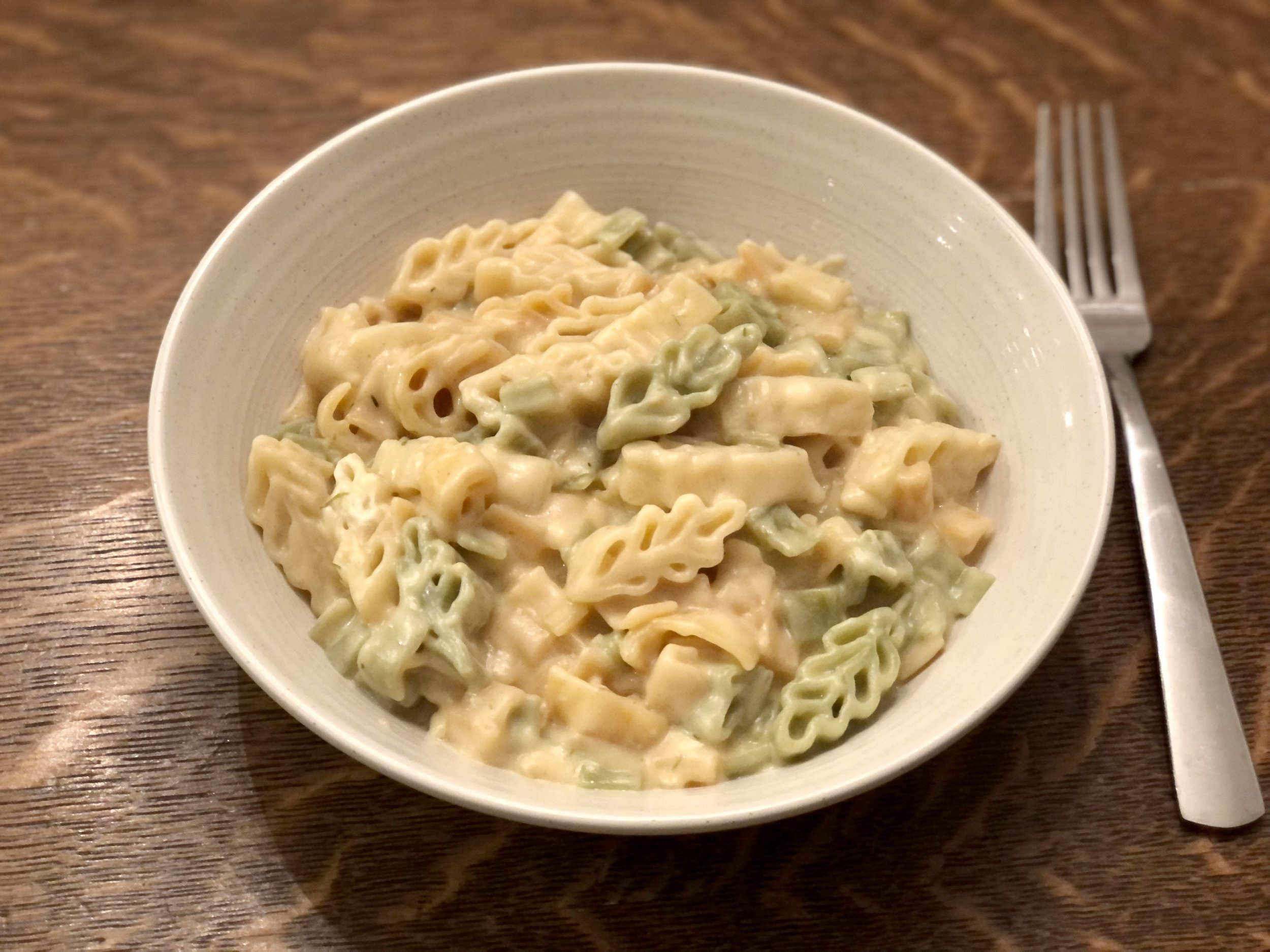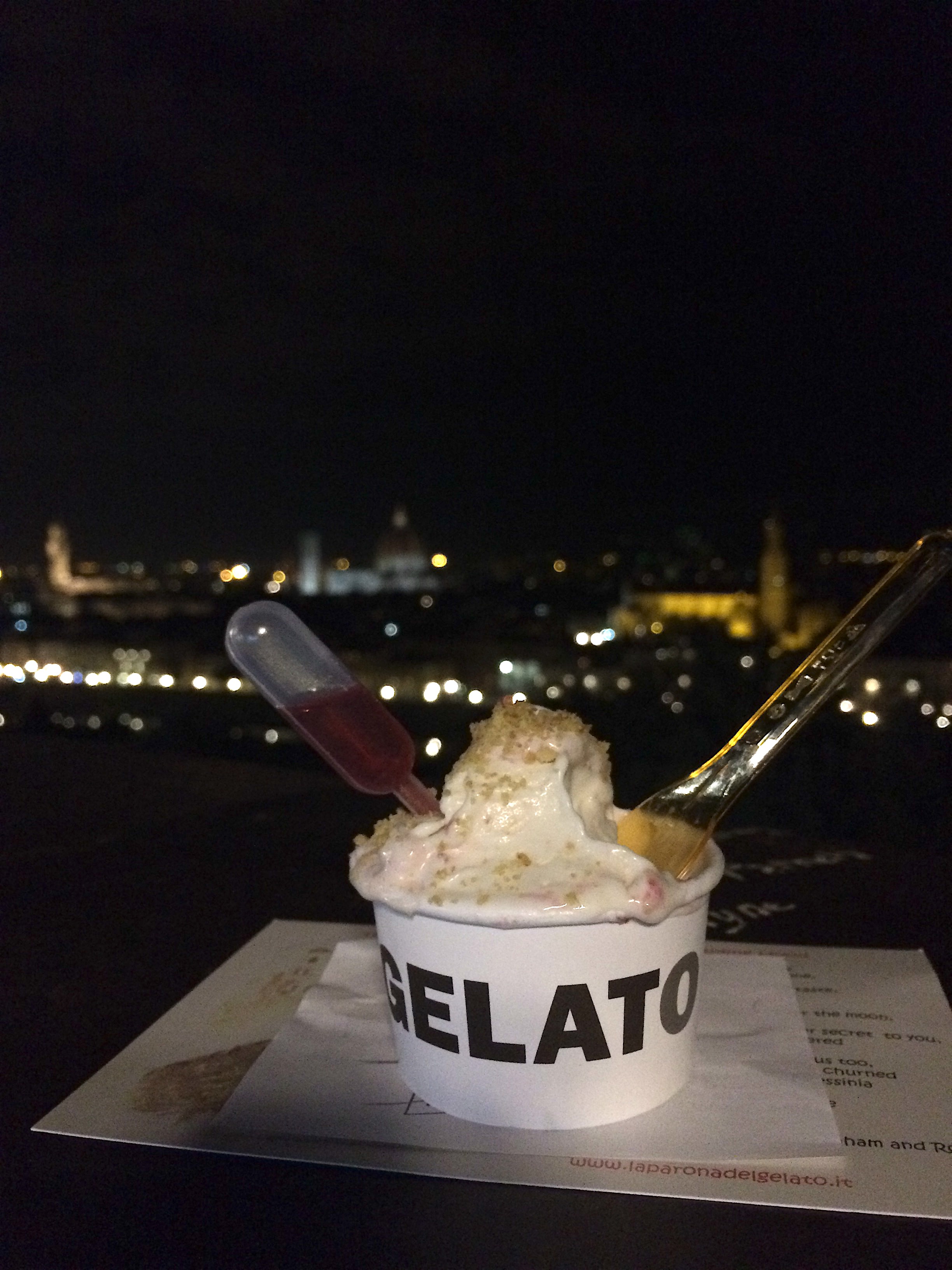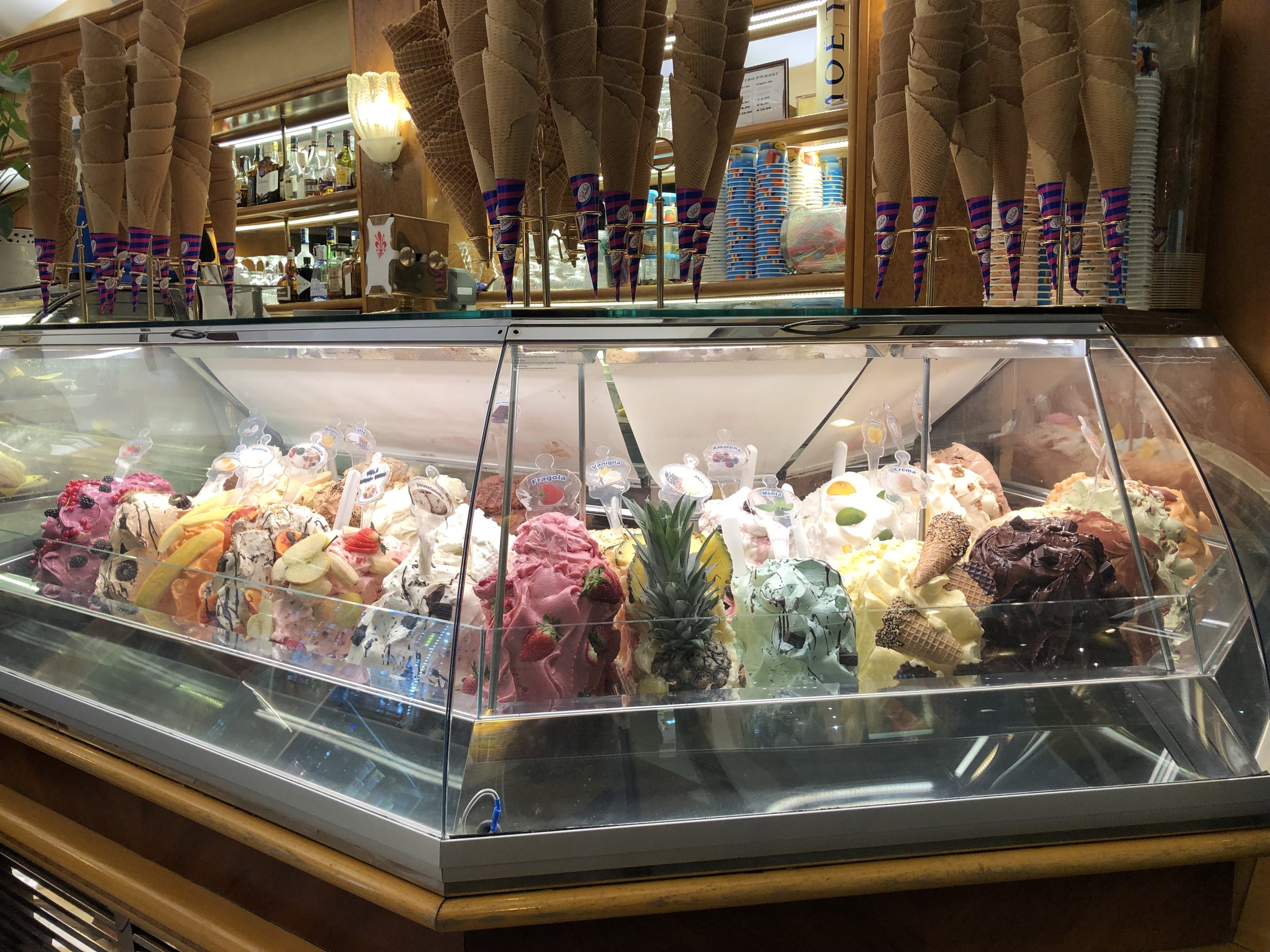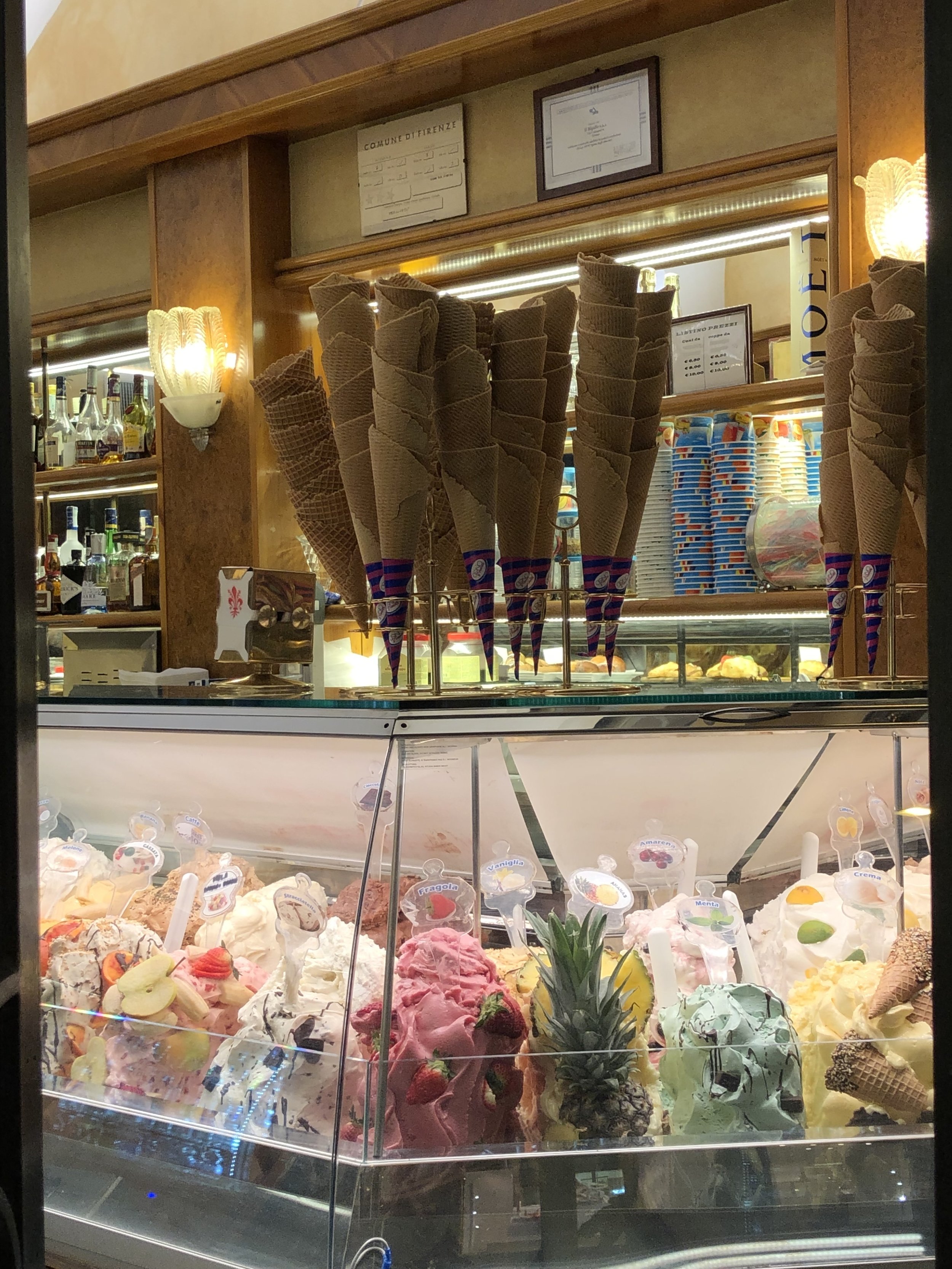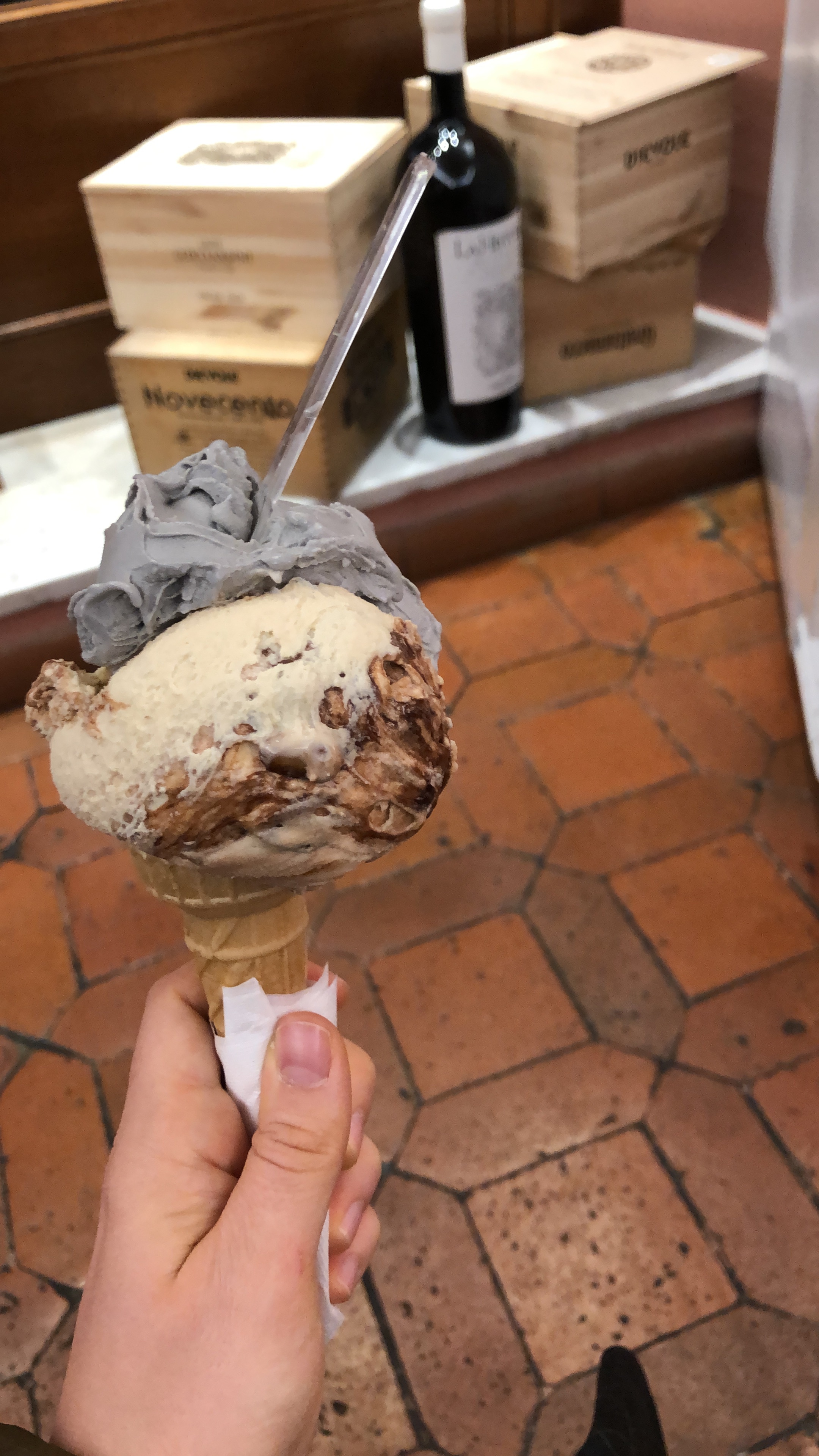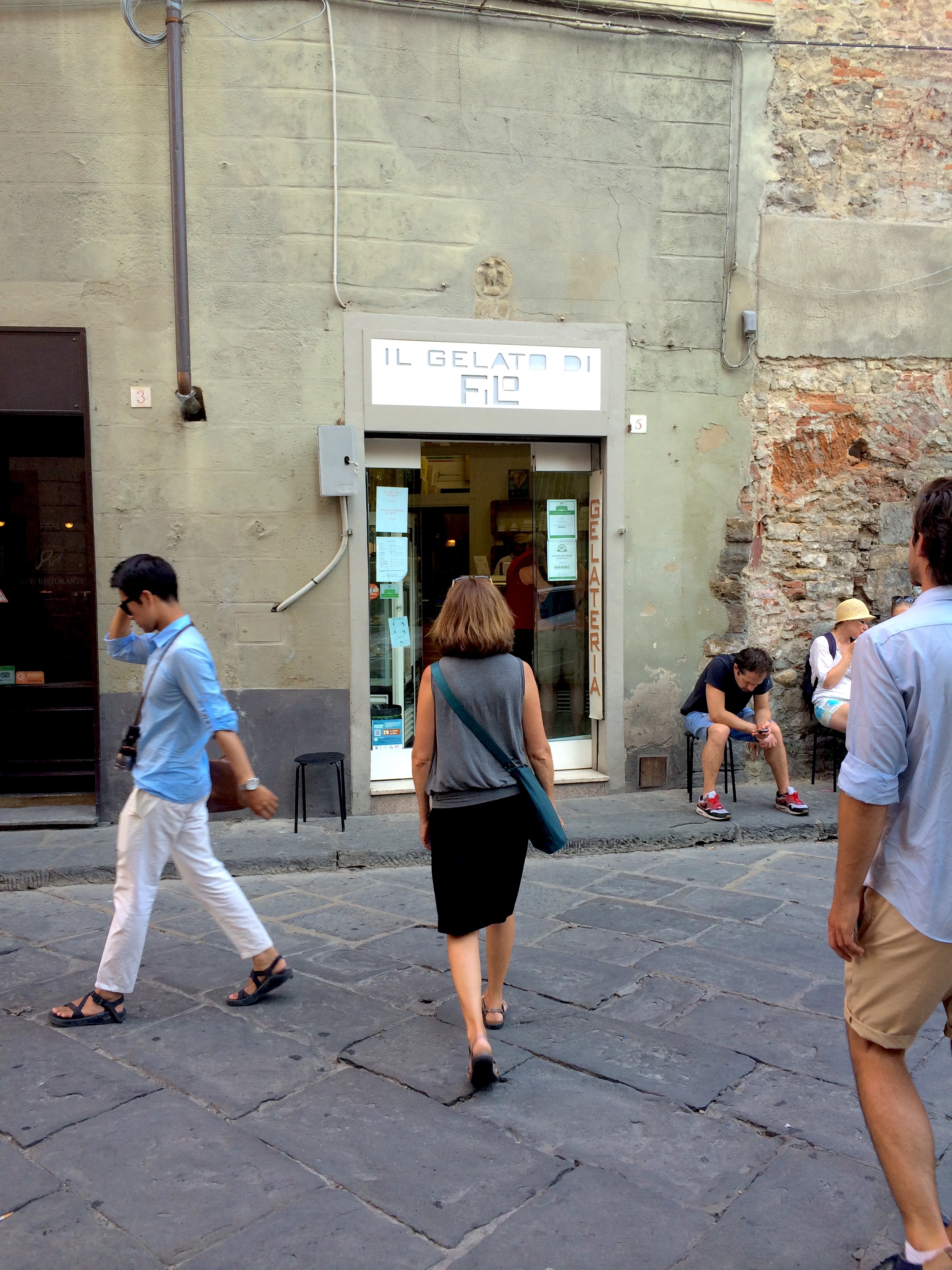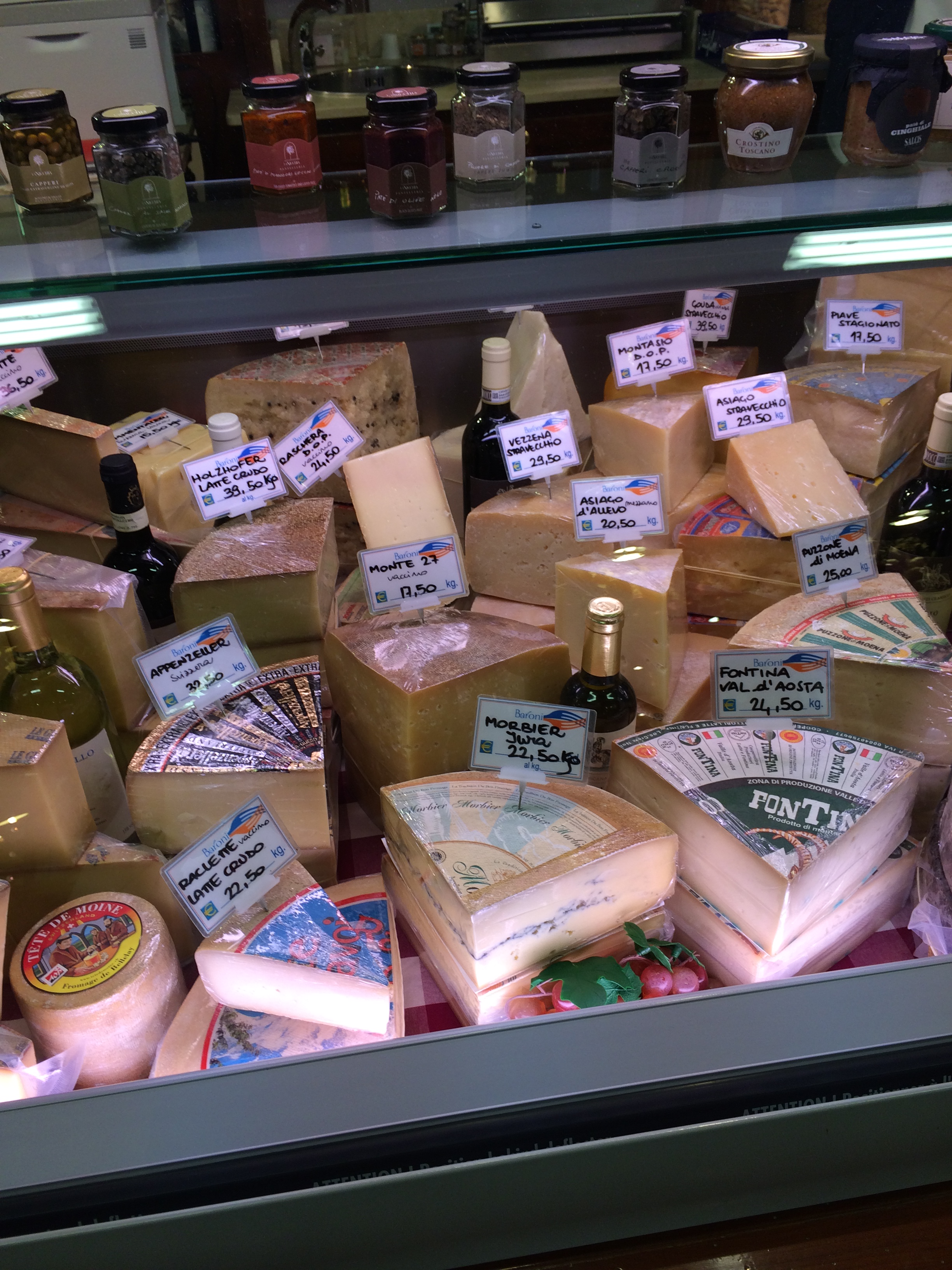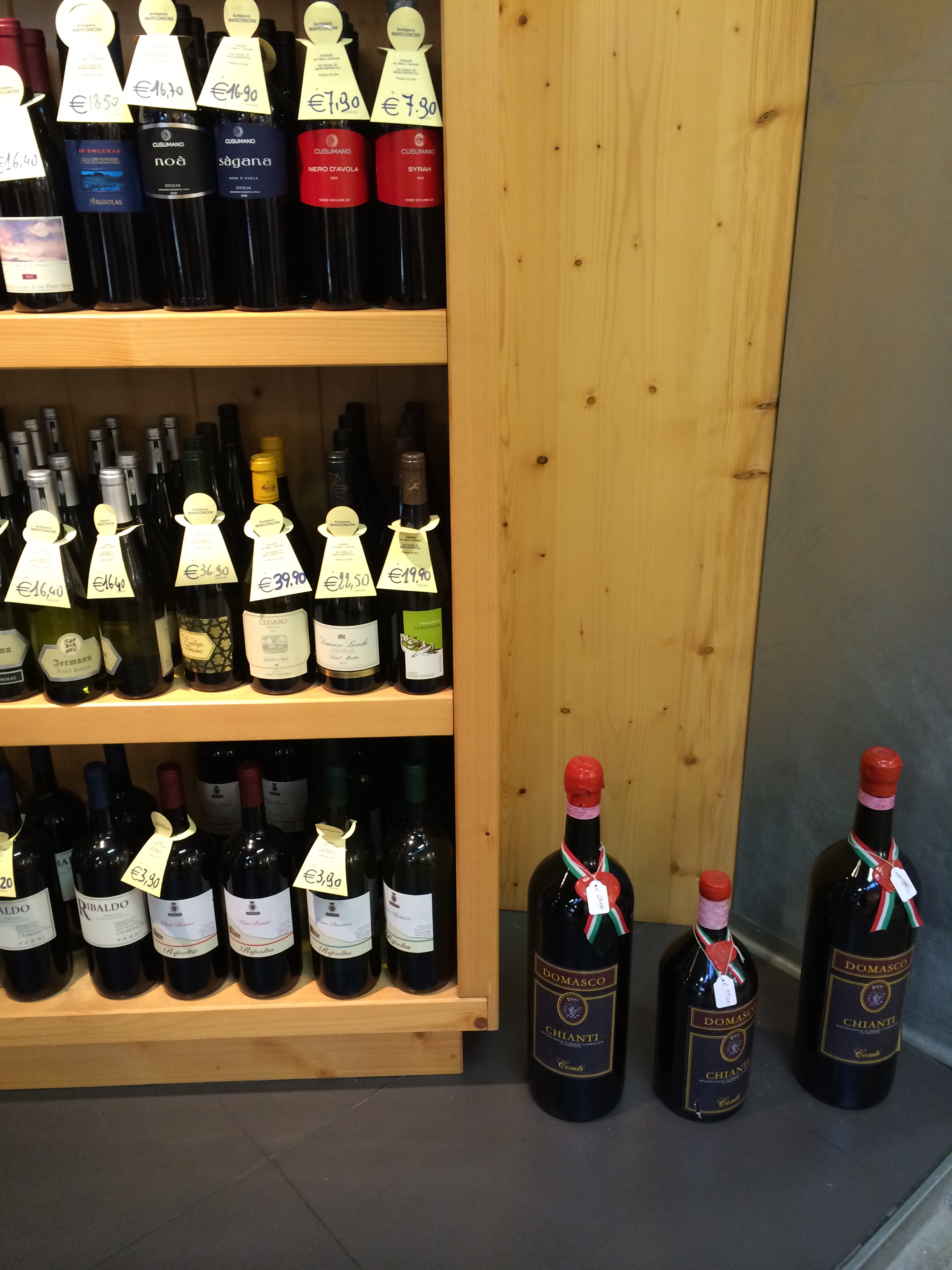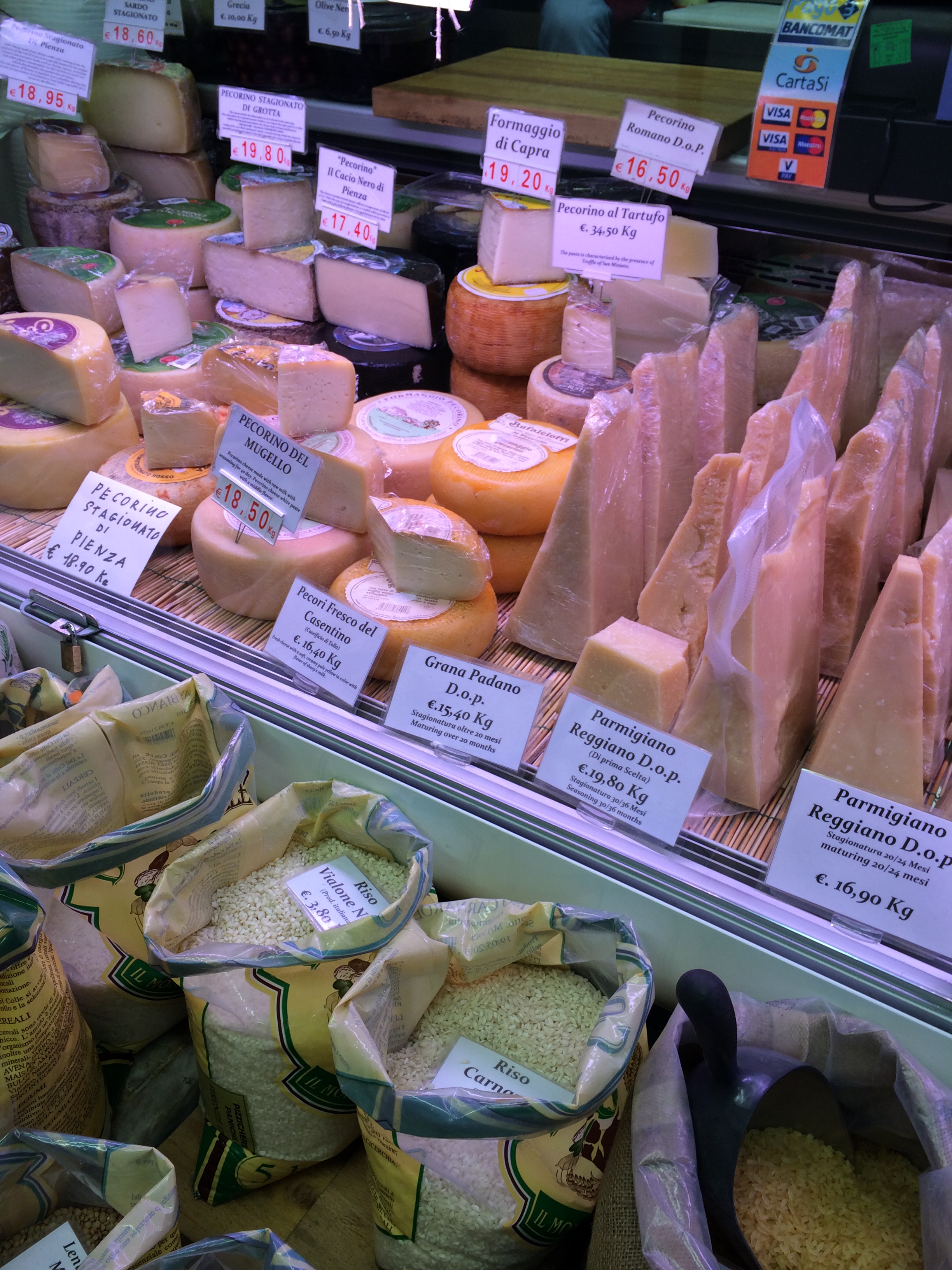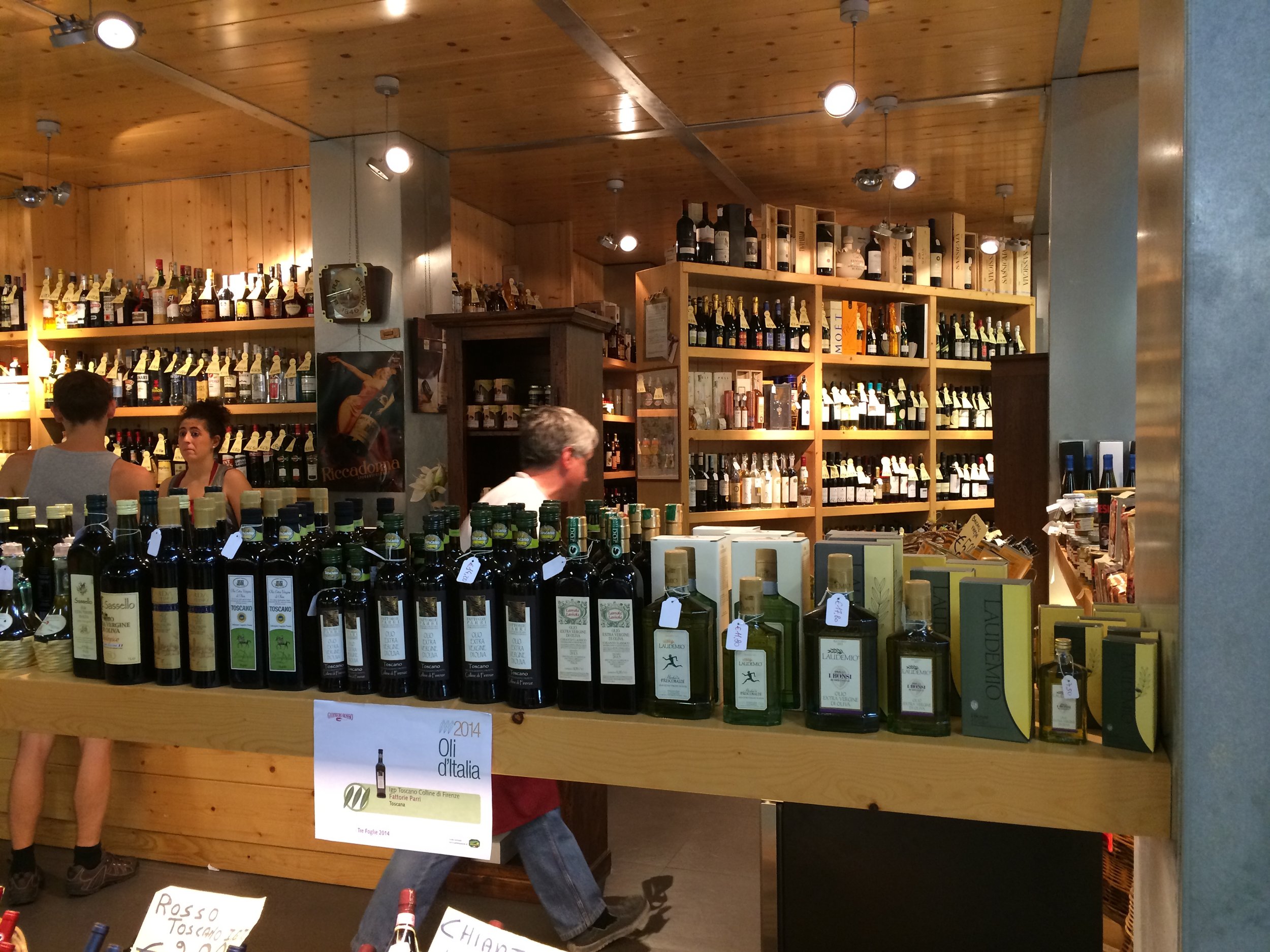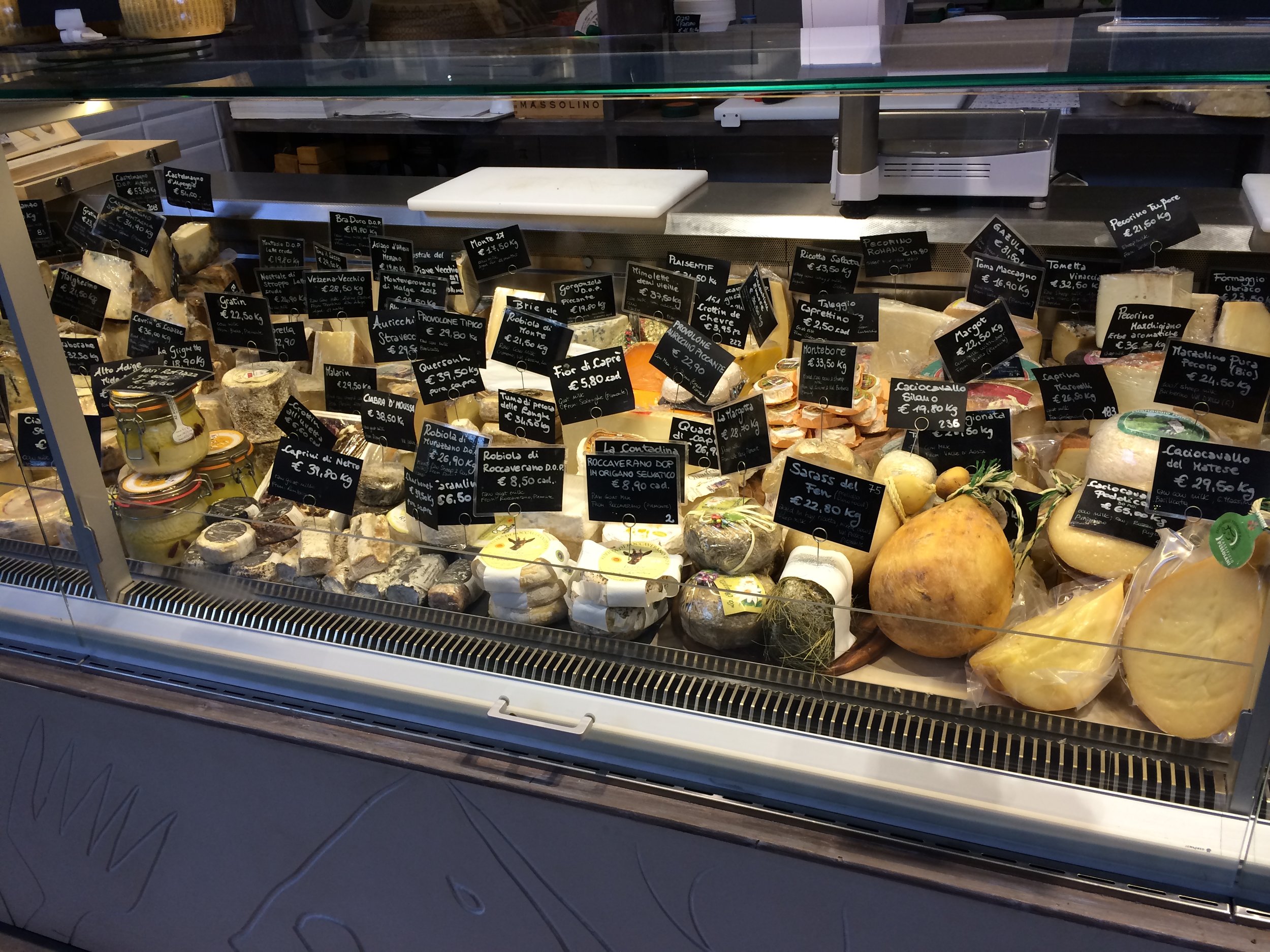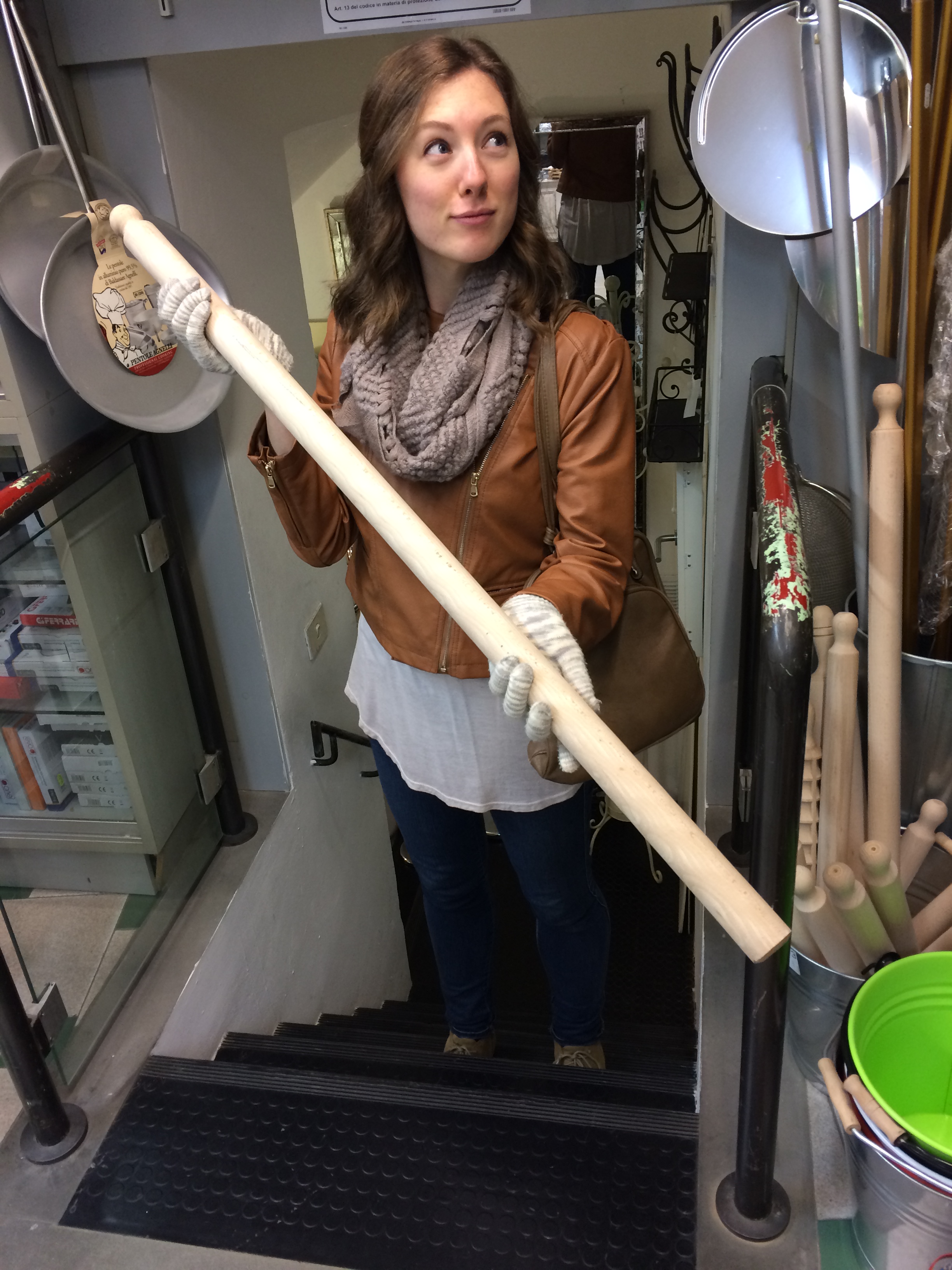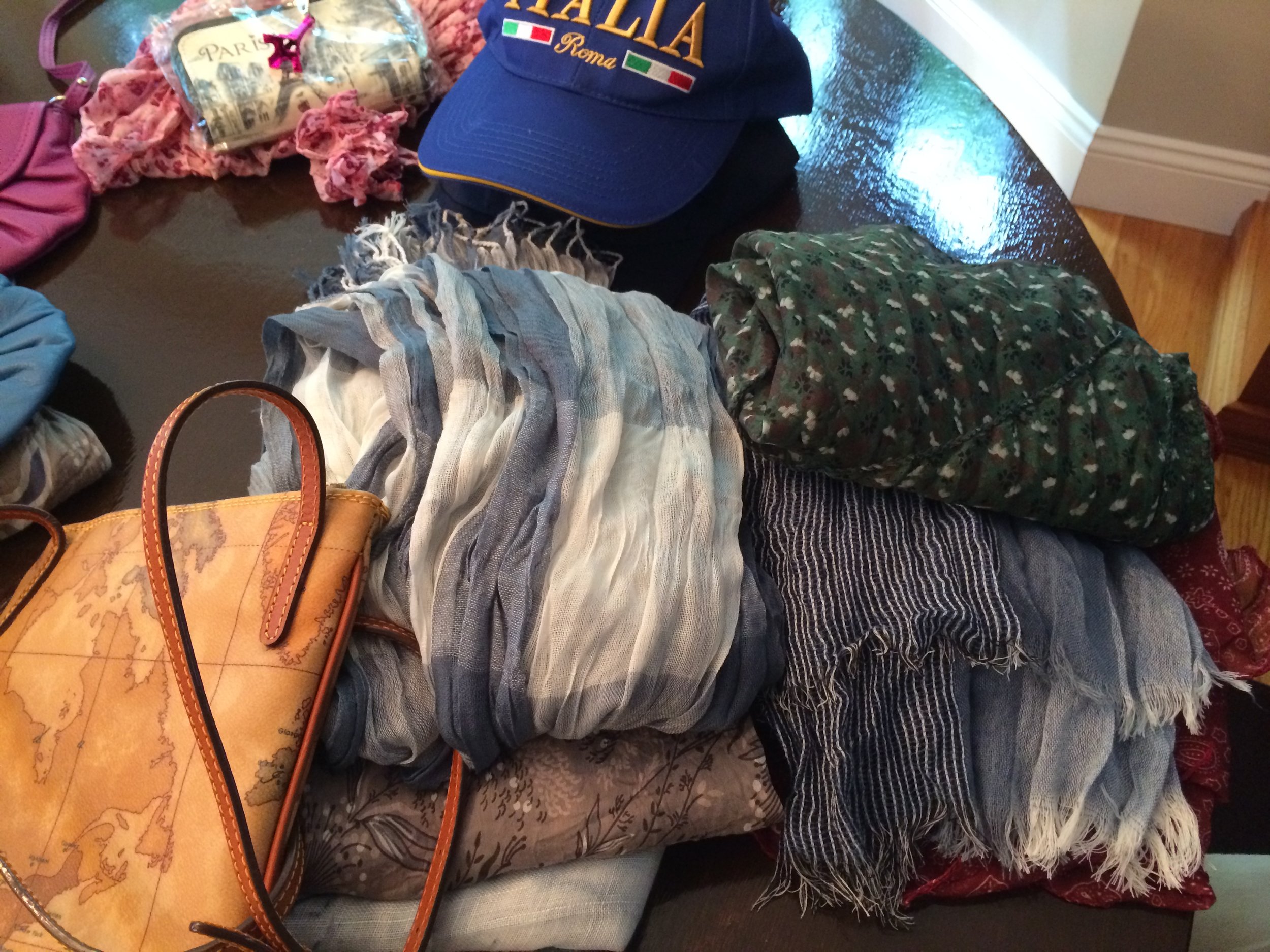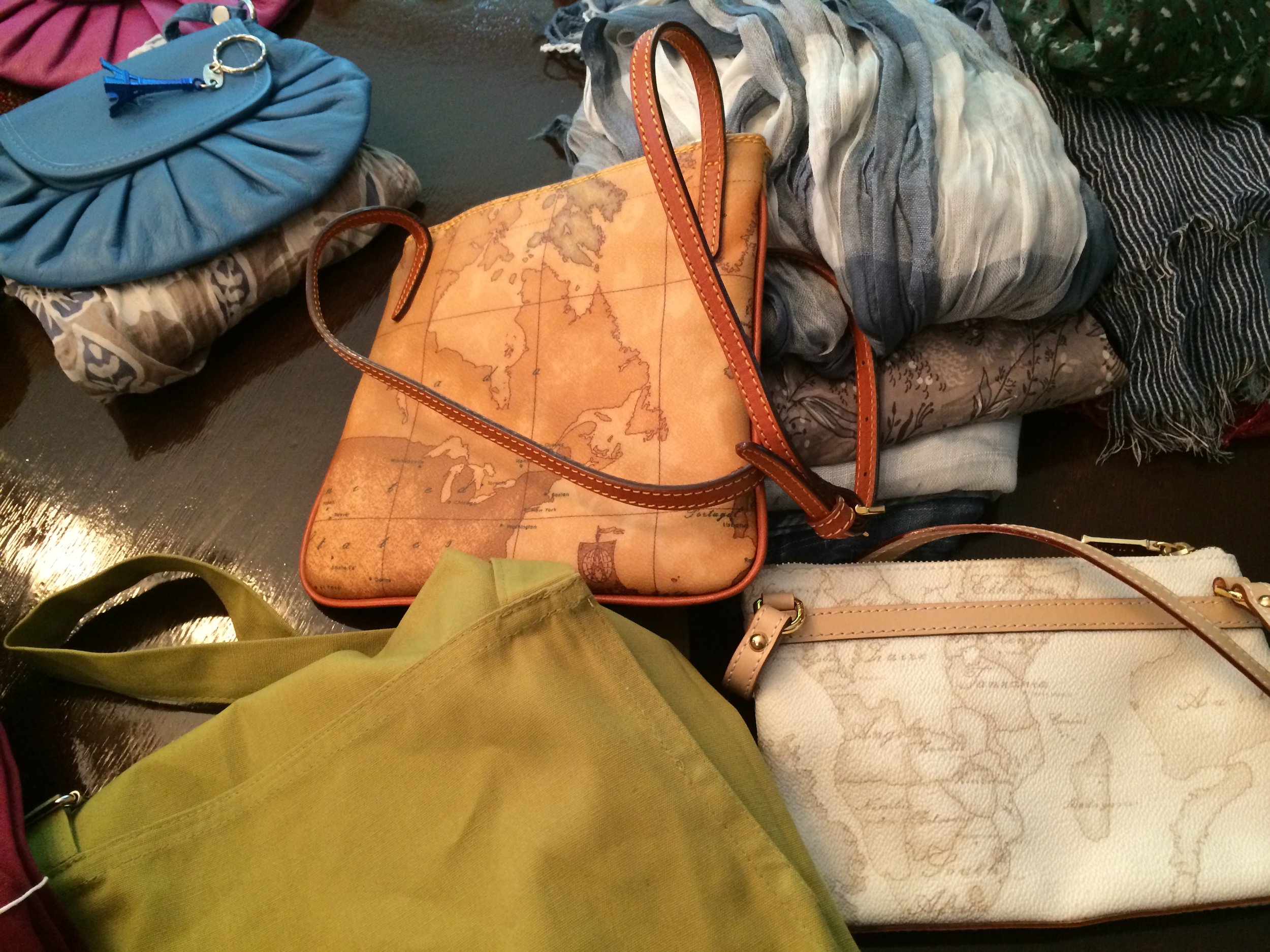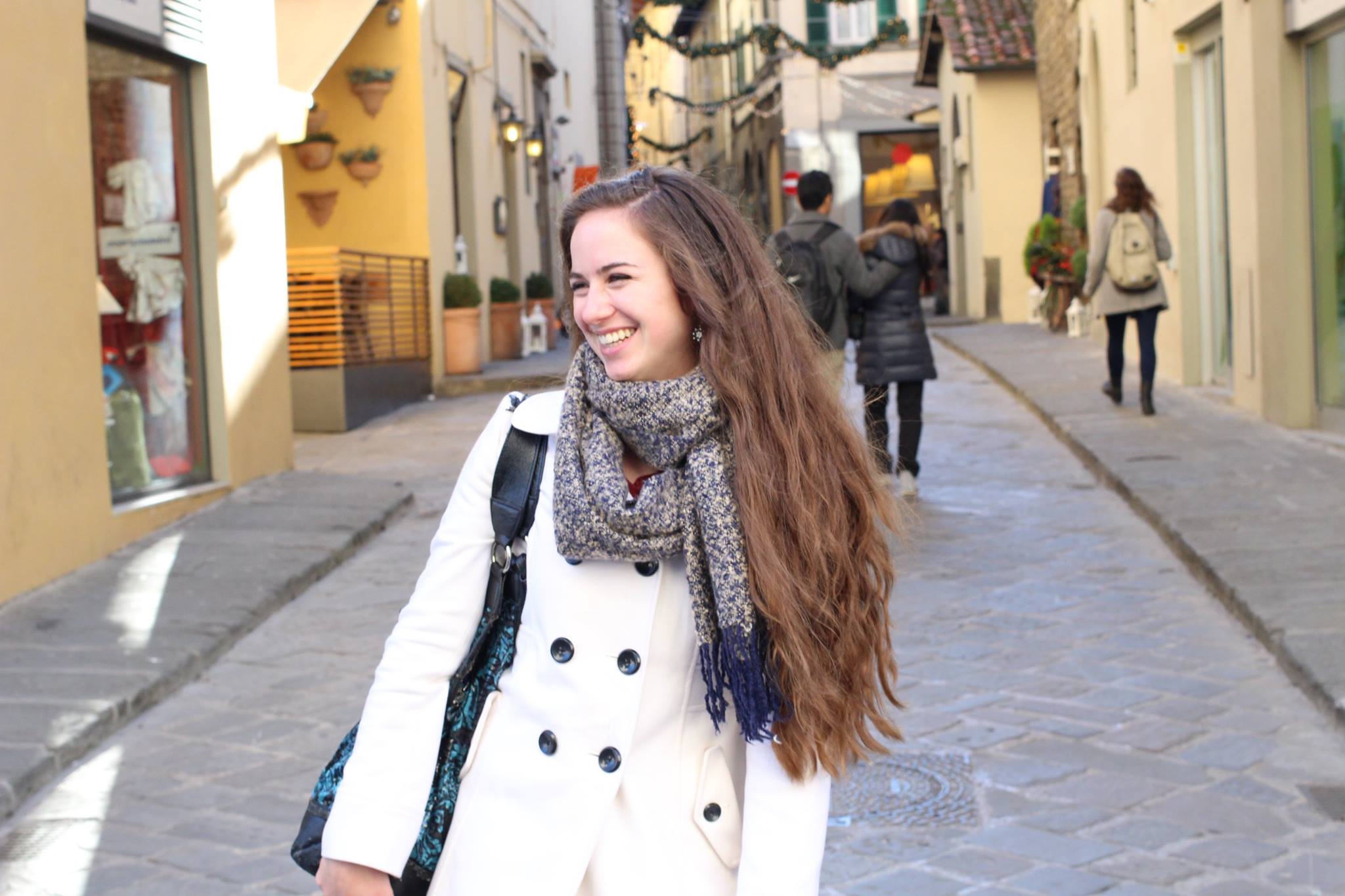Gelateria dei Neri*
One of my all time favorites, if you’ve read about any gelato in any guidebooks or blogs, you’ve probably seen Gelateria dei Neri pop up. And for good reason, it’s one of the best! They have a wide variety of flavors and also granita. There can be a line out the door at busy times, but no worries, it moves fast.
Price: Starting at 1.80 for cup or cone
Location: Via dei Neri 9, - City center, very close to the Church of Santa Croce
Flavor to Try: Cremino alla nocciola (Think vanilla gelato with copious amounts of Nutella swirled in, a very rich flavor), Cremino al Pistacchio (similar to the Cremino alla Nocciola, but with a pistachio cream), Limone (lemon), or Burro di Caramello Salato (salted caramel).
MySugar*
Winner of the Gelato Festival in Florence in 2016, this is the new kid on the block, only open since 2015 and quickly winning over hearts. This is also one of my favorites and the favorite of my friend Madeline. I would say that they have the absolute best consistency of all gelato I have tried in Florence. Their assortment of flavors is somewhat modest, but what they do, they do with excellence.
Price: Starting at 2.00 for a cup, 2.50 for a cone
Location: Via de’ Ginori 49r, - City center, around the corner from the Mercato Centrale
Flavor to try: Arachidi (peanut) or Limone
La Carraia*
I was introduced to this gelateria by my language partner as one of her favorites, and it quickly became one of mine as well. They have a great assortment of flavors.
Price: Starting at 1.00 for a “taste” cone, standard cup or cone from 1.80
Locations: Piazza Nazario Sauro 25r, at the end of the Carraia bridge, and Via de’ Benci 24r, very close to the Church of Santa Croce.
Sangelato*
This is the gelateria I go to most because it’s in my neighborhood! Still a 30 minute walk there, but that way you earn it, right? They have a selection of vegan flavors. Also to try are the crepes or Sicilian brioche stuffed with gelato! They have a great stracciatella (chocolate chip) and pistacchio!!
Price: Starting at 1.90 for cup or cone
Location: Via Marco Minghetti 17r, a bit out of the way on the east side of the city center, about a 15 minute bus ride from the center. Take the number 14A or 14B bus. This is very convenient if you have an airbnb on this side of town or staying at the Firenze Camping in Town, it’s on the way!
Perché No*
All-natural gelato and to boot they have several mousse flavors. Need I say more? This was the gelato shop of choice for my friend Hannah and I during our 2015 trip.
Price: Starting at 2.50 for cup or cone
Location: Via dei Tavolini 19r, between Palazzo Vecchio and the Duomo, right by the church of Orsanmichele.
Grom
By now Grom has become a recognizable international gelateria with locations well beyond its origin of Italy, including the USA, France, Japan, China, and more. I prefer to support small businesses when I can, not to mention the extra touch of love and care when the founder of a small business is present, but hey, Grom is delicious!
Price: Starting at 2.60 for cup or cone
Location: Via del Campanile 2, two steps away from the Duomo
Cantina del Gelato
This is the only gelateria where I have found a successful pumpkin flavor. A seasonal flavor to be sure, but their other flavors are often creative and delicious as well!
Price: Starting at 1.00 for a one-flavor kiddy cone, 2.00 for standard cup or cone
Location: There are two locations, one in Via de’ Bardi 31 on the south side of the Arno river very close to Ponte Vecchio, and the other near Piazza Beccaria in Borgo La Croce 30r on the east side of the city center.
La Strega Nocciola
I wasn’t originally a fan of this gelateria because their name means the hazelnut witch and their prices are on the more expensive end of gelato, 2.80 for a small. But good gelato is good gelato, and La Strega Nocciola has very good gelato, not to mention some unusual flavors: lavendar, white chocolate and cinnamon, etc.
Price: Starting at 2.80 for cup or cone
Location: There are 4 locations, the first in Via Ricasoli 16r, near the Duomo, the second in Via de’ Bardi 51r, on the south side of the Arno river very near to Ponte Vecchio, the third in Via dell’Olivuzzo 118, southwest of the city center near the Isolotto neighborhood, and the fourth in Piazza Giuseppe di Vittorio 3, even further southwest in Scandicci.
Il Gelato di Filo*
This gelateria will always hold a dear spot in my memory. It is conveniently located at the bottom of Piazzale Michelangelo, ya know, one of the most beautiful piazzas in Florence with its stunning vista of the city and also a sweat-inducing hike up to it? Yes. That one. This became the favorite gelato of my family and I when we visited in 2014, frequenting the shop multiple times in our 6 day tenure in Florence. We even had nicknames for the brother and sister who worked there. (We don’t actually know if they were related, but hey, it is part of our working theory.) We recommend either getting a gelato as an energy boost before you go up, or as a reward when you make it back down. Or, both before and after, because even that view will take it out of you. They also have some of the cheapest cones in Florence!
Price: Starting at 1.50 for a cone, 2.00 for a cup.
Location: Via San Miniato 5r, at the bottom of the side stairs (not the zig zag way up the front) up to Piazzale Michelangelo and San Miniato.
Badiani*
Badiani won the title in 2015 for the best gelato in Europe, and a year after opened a shop in London. Favorite shop of my friends the Pethtels, and lucky them, they live nearby! For the location being outside the city center I’d say they are a bit expensive, but they have a larger shop and indoor/outdoor seating, which is always a bonus.
Price: Starting at 2.00 for a cup, 3.00 for a cone
Location: Viale dei Mille 20r, outside the city center in the Campo di Marte neighborhood; about a 5 minute walk from the stadium or 10 minutes from the Campo di Marte train station.
Venchi
One of the best known Italian chocolate stores in Florence also has really yummy gelato! Their stores are generally a bit hectic, but busy because they are known and conveniently located. Their gelato is expensive, but worth the splurge for special occasions.
Price: Starting at 3.20 for cup or cone. Prices may vary by location.
Location: There are three locations, one at Piazza della Stazione 1 in the Santa Maria Novella train station, the second in Via Calzaiuoli 65r near the Duomo, and the third in Via Calimaruzza 18 near to Piazza della Signoria.
Gelateria de’ Medici
This gelateria has a wide selection of flavors and is open late, until midnight or 12:30am on Friday and Saturday.
Price: Starting at 2.00 for a cone, 3.00 for a cup
Location: There are two locations, one in Piazza Cesare Beccaria 7r on the eastern outskirts of the city center, and the second in Via dello Statuto 3/5r northwest of the city center.
Il Procopio*
This place is best suited to those who like “fantastic” flavors; those with lots of condiments such as chocolate and sauces and chunks of cake/cookies, etc. They have very few “pure” flavors, but I always see people walking around with the mango flavor, so it must be good! One of the favorites of the American blogger GirlinFlorence.
Price: Starting from 2.20 for cup or cone
Location: Via Pietrapiana 60/62r, not too far from the Church of Santa Croce; across from the Loggia del Pesce.
Il Gelato di Cristian Beduschi
On the first floor of the Mercato Centrale there is a wonderful gelato. They don’t have the widest selection of flavors, but you can also get chocolates, other desserts like tiramisù, and hot chocolate.
Price: Starting at 2.80 for cup or cone
Location: First floor ( aka second floor for Americans) of the Mercato Centrale on the same side as the pizza and pasta booths.
Edoardo*
Famous for their homemade cones and the scent that drifts well beyond their doors, Edoardo is the favorite gelateria of my friend Rachel. They are on the expensive side, but their gelato is organic and they have a good selection of vegan gelato and sorbet. Most of their flavors are beyond delicious, even if sometimes their menu can seem simple, but they have on occasion missed the mark with flavors and iciness. Beware, they often have a line, and in recent days they have implemented a number system. If you forget or don’t know to take a number, as was my experience, they may refuse to serve you. I waited 10 minutes in line and then they told me they can’t serve me unless I have a number, I wanted to make a humiliated beeline to the exit but my husband stood up for me and the customer whose turn it was graciously let me order anyway. I heard from other people after this incident that they still didn’t know about taking a number, so it very well may depend on if there’s a line and who’s working that day if they decide to implement the number system. Which is very…Italian. Anyway, you can find the numbers outside the door.
Price: Starting from 2.80 for a cup, 3.50 for a cone, cash only
Location: Piazza del Duomo 45r, two steps from the Duomo
Flavor to try: Zabaione
Vivoli
Heralded as a historic gelateria and one of the most famous in Florence, Vivoli delivers delicious gelato and a cute locale. However, because of their fame they tend to have lines and are on the expensive side, not to mention no cones.
Price: Starting at 2.00 for cup
Location: Via Isole delle Stinche 7r, near to the Church of Santa Croce
Sottozero
Gelato places like these won’t usually find themselves in guidebooks or on blog reviews because they are not in the city center and don’t get the foot traffic of tourists. This one is popular with students because it’s very near the university and dorm housing, and should be with you too if you have an airbnb nearby!
Price: Starting from 1.80 for cup or cone
Location: Via Anton Francesco Doni 47r, west of the city center in the neighborhood of Novoli
Flavor to try: Yogurt (sweetened with stevia!)
Rivareno
Gelato sourced from all-natural ingredients with interesting flavor combos.
Price: Starting at 2.30 for cup or cone
Location: Via Borgo degli Albizi 46r, not to far from the Duomo.
Carapina
This used to be one of my regular locations when I lived nearby, alas, no more.
Price: Starting at 2.00 for a cone with one flavor, 2.50 for cup or cone with two flavors
Location: Piazza Oberdan 2r, just east of the city center, but in the summer they also have a food truck down by the Arno!
La Gelateria Il Sorriso
Generous portions and lots of flavors, I believe this is also one of the few places that lets you put 3 flavors even in the smallest size cone or cup! Win.
Price: Starting at 2.20 for cup or cone
Location: Via Erbosa 70, a bit out of the way in the neighborhood of Gavinana southeast of the city center, but if you are staying in the area or just want to experience an Italian neighborhood with zero tourists, head on down there. Take the bus numbers 8, 23, 31, or 32 to get there from Piazza San Marco, about 20 minutes.
La Caminia
This gelateria really surprised me with their gelato. I walk by every once in awhile but had never gone in due to the generally bright color themes that usually denote a tourist trap. Then they made a special flavor in honor of the 200th(?) anniversary of the US consulate mission to Florence and I had to go try it. In doing so I discovered a wonderful new gelato stop with many flavors to choose from with even the simplest bursting with creamy flavor.
Price: Starting at around 2.00 for cup or cone (I need to double check this)
Location: Like Gelateria Il Sorriso above, La Caminia is found in the Gavinana neighborhood not far from the large Coop supermarket.
Gelateria Santa Trinita
Due to its location and overall appearance this place can sometimes be mistaken for “tourist” gelato. Fret not, not only is it uber-creamy, but it is decently priced with generous portions!
Price: Starting at 2.20 for cup or cone
Location: Piazza dei Frescobaldi, 8r, at the end of the Ponte Santa Trinita; one bridge over from Ponte Vecchio.
Flavor to Try: They are known for their Sesamo Nero (Black Sesame), it’s subtle and nutty and mysterious.
Gelateria della Passera
Recommended especially for those who love fruit flavors!
Price: Starting at 2.00 for two-flavor cup or cone
Location: Via Toscanella 15r, on the south side of the Arno in the Santo Spirito neighborhood; very close to the Palazzo Pitti.
Donamalina Cure Cioccolateria - Gelateria
Another place a bit outside of the city center, but we have to cover all bases, don’t we? They have chocolate and confections, too!
Price: Starting at 2.00 for cup or cone
Location: Via Antonio Pacinotti 30r, bit north of the city center in the neighborhood of Le Cure.
Le Botteghe di Leonardo*
Natural gelato with a good selection of dairy-free, but their milk-based flavors are pretty great! Some even use latte di bufala, that is, water buffalo milk, and it’s extra creamy. Favorite of my friend, Brianna!
Price: Starting at 2.60 for cup or cone
Location: Via de’ Ginori 21r, very close to the Mercato Centrale.
Flavor to try: Kabana (kiwi and banana), stracciatella

